instrument panel Citroen DS5 2013.5 1.G Owner's Guide
[x] Cancel search | Manufacturer: CITROEN, Model Year: 2013.5, Model line: DS5, Model: Citroen DS5 2013.5 1.GPages: 372, PDF Size: 32.58 MB
Page 75 of 372
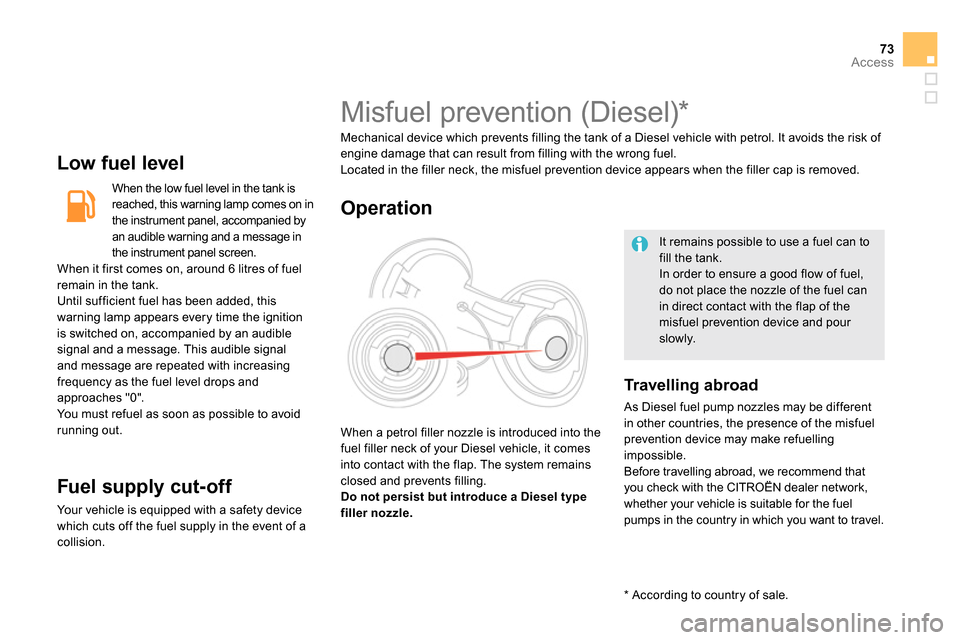
73Access
Low fuel level
When the low fuel level in the tank is
reached, this warning lamp comes on in
the instrument panel, accompanied by
an audible warning and a message in
the instrument panel screen.
When it first comes on, around 6 litres of fuel
remain in the tank.
Until sufficient fuel has been added, this
warning lamp appears every time the ignition
is switched on, accompanied by an audible
signal and a message. This audible signal
and message are repeated with increasing
frequency as the fuel level drops and
approaches "0".
You must refuel as soon as possible to avoid
running out.
Fuel supply cut- of f
Your vehicle is equipped with a safety device
which cuts off the fuel supply in the event of a
collision. It remains possible to use a fuel can to
fill the tank.
In order to ensure a good flow of fuel,
do not place the nozzle of the fuel can
in direct contact with the flap of the
misfuel prevention device and pour
slowly.
Misfuel prevention (Diesel) *
Mechanical device which prevents filling the tank of a Diesel vehicle with petrol. It avoids the risk of
engine damage that can result from filling with the wrong fuel.
Located in the filler neck, the misfuel prevention device appears when the filler cap is removed.
When a petrol filler nozzle is introduced into the
fuel filler neck of your Diesel vehicle, it comes
into contact with the flap. The system remains
closed and prevents filling.
Do not persist but introduce a Diesel type
filler nozzle.
Operation
Travelling abroad
As Diesel fuel pump nozzles may be different
in other countries, the presence of the misfuel
prevention device may make refuelling
impossible.
Before travelling abroad, we recommend that
you check with the CITROËN dealer network,
whether your vehicle is suitable for the fuel
pumps in the country in which you want to travel.
*
According to country of sale.
Page 92 of 372
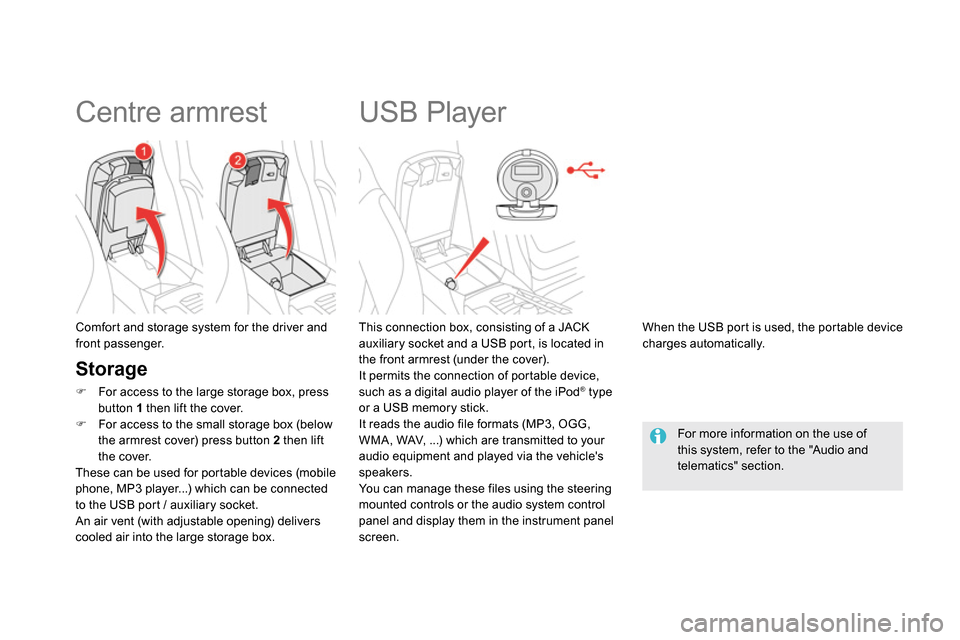
USB Player
This connection box, consisting of a JACK
auxiliary socket and a USB port, is located in
the front armrest (under the cover).
It permits the connection of portable device,
such as a digital audio player of the iPod
® type
or a USB memory stick.
It reads the audio file formats (MP3, OGG,
WMA, WAV, ...) which are transmitted to your
audio equipment and played via the vehicle's
speakers.
You can manage these files using the steering
mounted controls or the audio system control
panel and display them in the instrument panel
screen.
When the USB por t is used, the por table device
charges automatically.
For more information on the use of
this system, refer to the "Audio and
telematics" section. Comfort and storage system for the driver and
front passenger.
Centre armrest
Storage
For access to the large storage box, press
button 1
then lift the cover.
For access to the small storage box (below
the armrest cover) press button 2
then lift
the cover.
These can be used for portable devices (mobile
phone, MP3 player...) which can be connected
to the USB port / auxiliary socket.
An air vent (with adjustable opening) delivers
cooled air into the large storage box.
Page 106 of 372
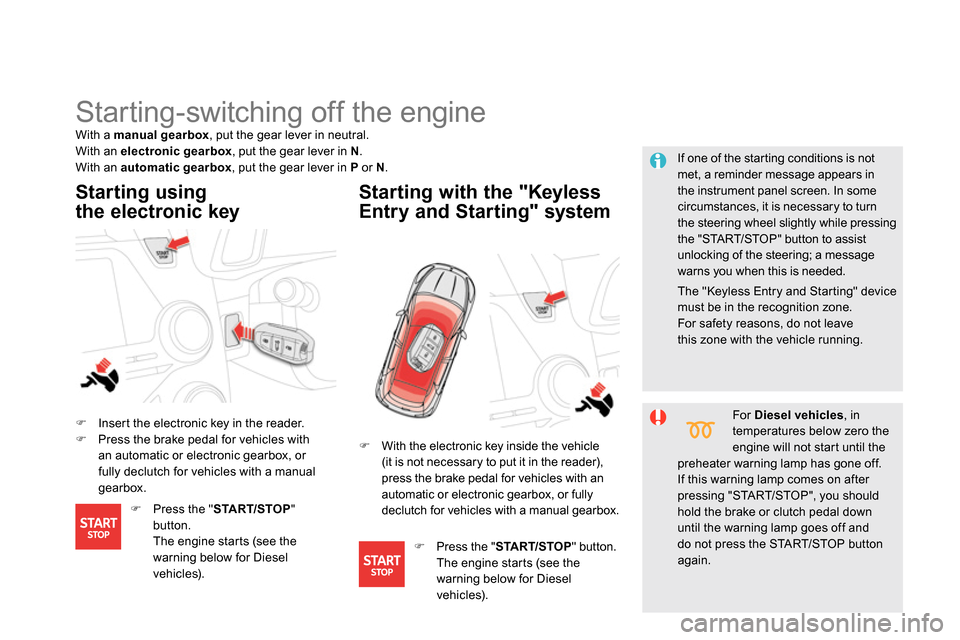
Starting-switching off the engine
Insert the electronic key in the reader.
Press the brake pedal for vehicles with
an automatic or electronic gearbox, or
fully declutch for vehicles with a manual
gearbox.
Starting using
the electronic key
Starting with the "Keyless
Entry and Starting" system
If one of the starting conditions is not
met, a reminder message appears in
the instrument panel screen. In some
circumstances, it is necessary to turn
the steering wheel slightly while pressing
the "START/STOP" button to assist
unlocking of the steering; a message
warns you when this is needed.
With a manual gearbox
, put the gear lever in neutral.
With an electronic gearbox
, put the gear lever in N
.
With an automatic gearbox
, put the gear lever in P
or N
.
For Diesel vehicles
, in
temperatures below zero the
engine will not start until the
preheater warning lamp has gone off.
If this warning lamp comes on after
pressing "START/STOP", you should
hold the brake or clutch pedal down
until the warning lamp goes off and
do not press the START/STOP button
again.
With the electronic key inside the vehicle
(it is not necessary to put it in the reader),
press the brake pedal for vehicles with an
automatic or electronic gearbox, or fully
declutch for vehicles with a manual gearbox.
Press the " START/STOP
"
button.
The engine starts (see the
warning below for Diesel
vehicles).
Press the " START/STOP
" button.
The engine starts (see the
warning below for Diesel
vehicles).
The "Keyless Entry and Starting" device
must be in the recognition zone.
For safety reasons, do not leave
this zone with the vehicle running.
Page 107 of 372
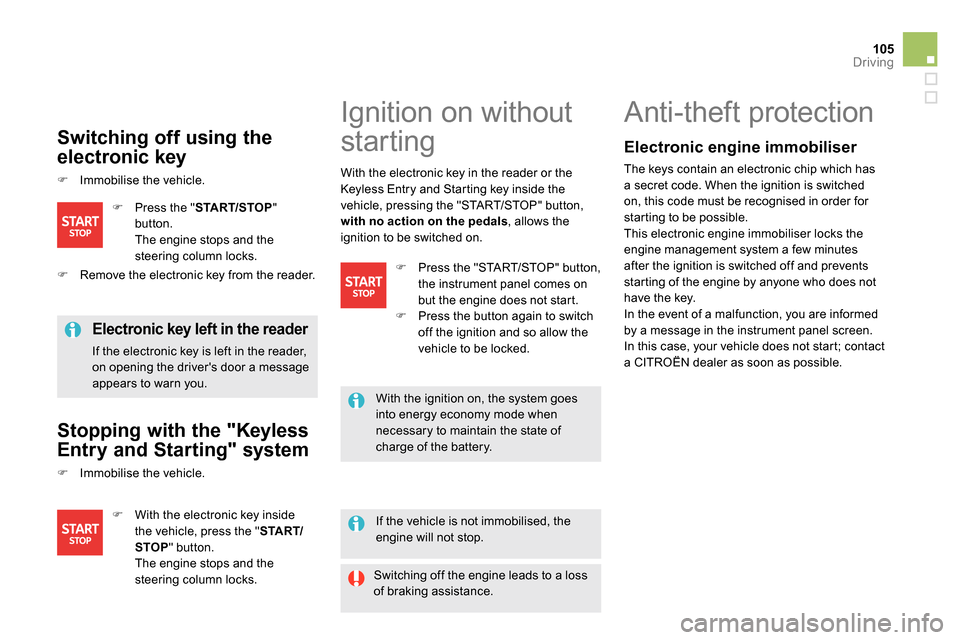
105Driving
Switching off using the
electronic key
Immobilise the vehicle.
Electronic key left in the reader
If the electronic key is left in the reader,
on opening the driver's door a message
appears to warn you.
Stopping with the "Keyless
Entry and Starting" system
Immobilise the vehicle.
If the vehicle is not immobilised, the
engine will not stop.
Ignition on without
starting
With the electronic key inside
the vehicle, press the " START/
STOP
" button.
The engine stops and the
steering column locks.
Press the " START/STOP
"
button.
The engine stops and the
steering column locks.
Anti-theft protection
Electronic engine immobiliser
The keys contain an electronic chip which has
a secret code. When the ignition is switched
on, this code must be recognised in order for
starting to be possible.
This electronic engine immobiliser locks the
engine management system a few minutes
after the ignition is switched off and prevents
starting of the engine by anyone who does not
have the key.
In the event of a malfunction, you are informed
by a message in the instrument panel screen.
In this case, your vehicle does not start; contact
a CITROËN dealer as soon as possible.
With the electronic key in the reader or the
Keyless Entry and Starting key inside the
vehicle, pressing the "START/STOP" button,
with no action on the pedals
, allows the
ignition to be switched on.
Remove the electronic key from the reader.
Press the "START/STOP" button,
the instrument panel comes on
but the engine does not start.
Press the button again to switch
off the ignition and so allow the
vehicle to be locked.
With the ignition on, the system goes
into energy economy mode when
necessary to maintain the state of
charge of the battery.
Switching off the engine leads to a loss
of braking assistance.
Page 108 of 372
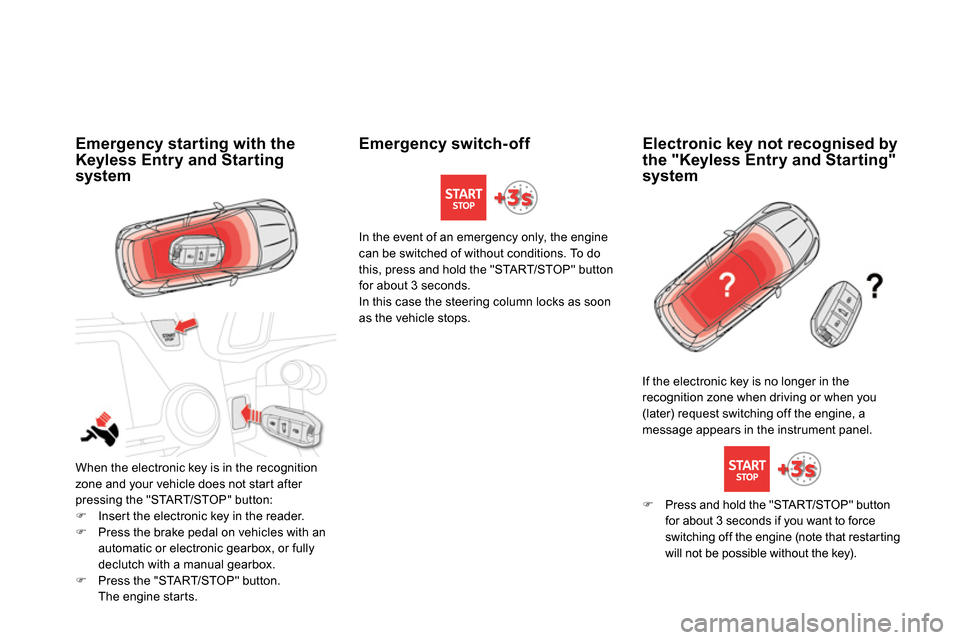
Emergency starting with the
Keyless Entry and Starting
system
When the electronic key is in the recognition
zone and your vehicle does not start after
pressing the "START/STOP" button:
Insert the electronic key in the reader.
Press the brake pedal on vehicles with an
automatic or electronic gearbox, or fully
declutch with a manual gearbox.
Press the "START/STOP" button.
The engine starts.
In the event of an emergency only, the engine
can be switched of without conditions. To do
this, press and hold the "START/STOP" button
for about 3 seconds.
In this case the steering column locks as soon
as the vehicle stops.
If the electronic key is no longer in the
recognition zone when driving or when you
(later) request switching off the engine, a
message appears in the instrument panel.
Emergency switch- off
Electronic key not recognised by
the "Keyless Entry and Starting"
system
Press and hold the "START/STOP" button
for about 3 seconds if you want to force
switching off the engine (note that restarting
will not be possible without the key).
Page 109 of 372
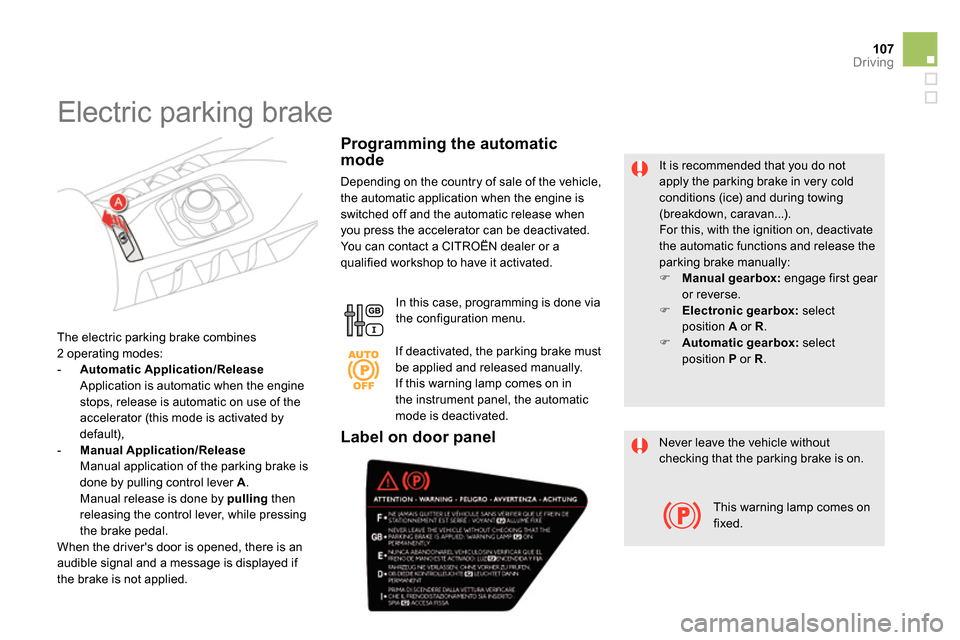
107Driving
It is recommended that you do not
apply the parking brake in very cold
conditions (ice) and during towing
(breakdown, caravan...).
For this, with the ignition on, deactivate
the automatic functions and release the
parking brake manually:
Manual gearbox:
engage first gear
or reverse.
Electronic gearbox:
select
position A
or R
.
Automatic gearbox:
select
position P
or R
.
The electric parking brake combines
2 operating modes:
- Automatic Application/Release
Application is automatic when the engine
stops, release is automatic on use of the
accelerator (this mode is activated by
default),
- Manual Application/Release
Manual application of the parking brake is
done by pulling control lever A.
Manual release is done by pulling
then
releasing the control lever, while pressing
the brake pedal.
When the driver's door is opened, there is an
audible signal and a message is displayed if
the brake is not applied.
Programming the automatic
mode
Depending on the country of sale of the vehicle,
the automatic application when the engine is
switched off and the automatic release when
you press the accelerator can be deactivated.
You can contact a CITROËN dealer or a
qualified workshop to have it activated.
In this case, programming is done via
the configuration menu.
Electric parking brake
If deactivated, the parking brake must
be applied and released manually.
If this warning lamp comes on in
the instrument panel, the automatic
mode is deactivated.
Never leave the vehicle without
checking that the parking brake is on.
This warning lamp comes on
fixed.
Label on door panel
Page 110 of 372
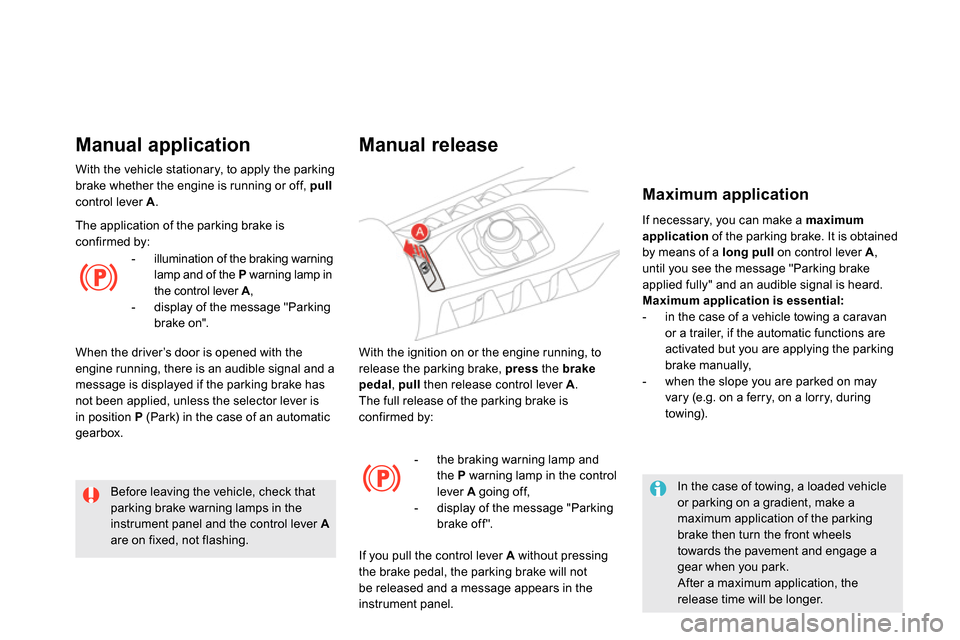
With the ignition on or the engine running, to
release the parking brake, press
the brake
pedal
, pull
then release control lever A
.
The full release of the parking brake is
confirmed by:
Manual release
- the braking warning lamp and
the P
warning lamp in the control
lever A
going off,
- display of the message "Parking
brake off ".
If you pull the control lever A
without pressing
the brake pedal, the parking brake will not
be released and a message appears in the
instrument panel.
If necessary, you can make a maximum
application
of the parking brake. It is obtained
by means of a long pull
on control lever A
,
until you see the message "Parking brake
applied fully" and an audible signal is heard.
Maximum application is essential:
- in the case of a vehicle towing a caravan
or a trailer, if the automatic functions are
activated but you are applying the parking
brake manually,
- when the slope you are parked on may
vary (e.g. on a ferry, on a lorry, during
towing).
Maximum application
In the case of towing, a loaded vehicle
or parking on a gradient, make a
maximum application of the parking
brake then turn the front wheels
towards the pavement and engage a
gear when you park.
After a maximum application, the
release time will be longer.
Before leaving the vehicle, check that
parking brake warning lamps in the
instrument panel and the control lever A
are on fixed, not flashing.
With the vehicle stationary, to apply the parking
brake whether the engine is running or off, pull
control lever A
.
Manual application
The application of the parking brake is
confirmed by:
- illumination of the braking warning
lamp and of the P
warning lamp in
the control lever A
,
- display of the message "Parking
brake on".
When the driver’s door is opened with the
engine running, there is an audible signal and a
message is displayed if the parking brake has
not been applied, unless the selector lever is
in position P
(Park) in the case of an automatic
gearbox.
Page 111 of 372
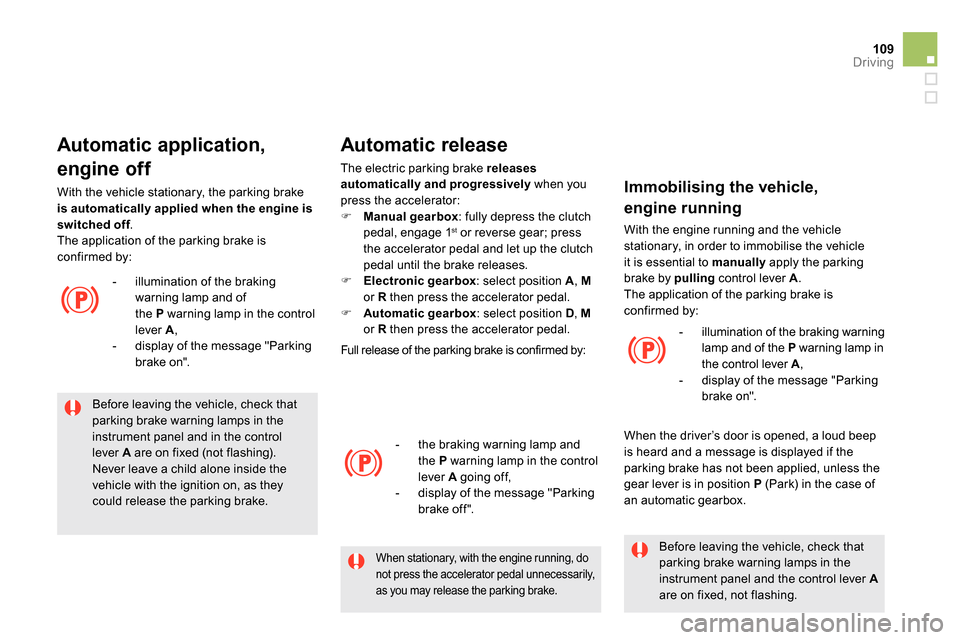
109Driving
Before leaving the vehicle, check that
parking brake warning lamps in the
instrument panel and in the control
lever A
are on fixed (not flashing).
Never leave a child alone inside the
vehicle with the ignition on, as they
could release the parking brake.
Automatic application,
engine off
- illumination of the braking
warning lamp and of
the P
warning lamp in the control
lever A
,
- display of the message "Parking
brake on". With the vehicle stationary, the parking brake
is automatically applied when the engine is
switched off.
The application of the parking brake is
confirmed by:
Automatic release
The electric parking brake releases
automatically and progressively
when you
press the accelerator:
Manual gearbox
: fully depress the clutch
pedal, engage 1
st or reverse gear; press
the accelerator pedal and let up the clutch
pedal until the brake releases.
Electronic gearbox
: select position A
, M
or R
then press the accelerator pedal.
Automatic gearbox
: select position D
, M
or R
then press the accelerator pedal.
Full release of the parking brake is confirmed by:
- the braking warning lamp and
the P
warning lamp in the control
lever A
going off,
- display of the message "Parking
brake off ".
When stationary, with the engine running, do
not press the accelerator pedal unnecessarily,
as you may release the parking brake.
Before leaving the vehicle, check that
parking brake warning lamps in the
instrument panel and the control lever A
are on fixed, not flashing.
Immobilising the vehicle,
engine running
With the engine running and the vehicle
stationary, in order to immobilise the vehicle
it is essential to manually
apply the parking
brake by pulling
control lever A
.
The application of the parking brake is
confirmed by:
- illumination of the braking warning
lamp and of the P
warning lamp in
the control lever A
,
- display of the message "Parking
brake on".
When the driver’s door is opened, a loud beep
is heard and a message is displayed if the
parking brake has not been applied, unless the
gear lever is in position P
(Park) in the case of
an automatic gearbox.
Page 115 of 372
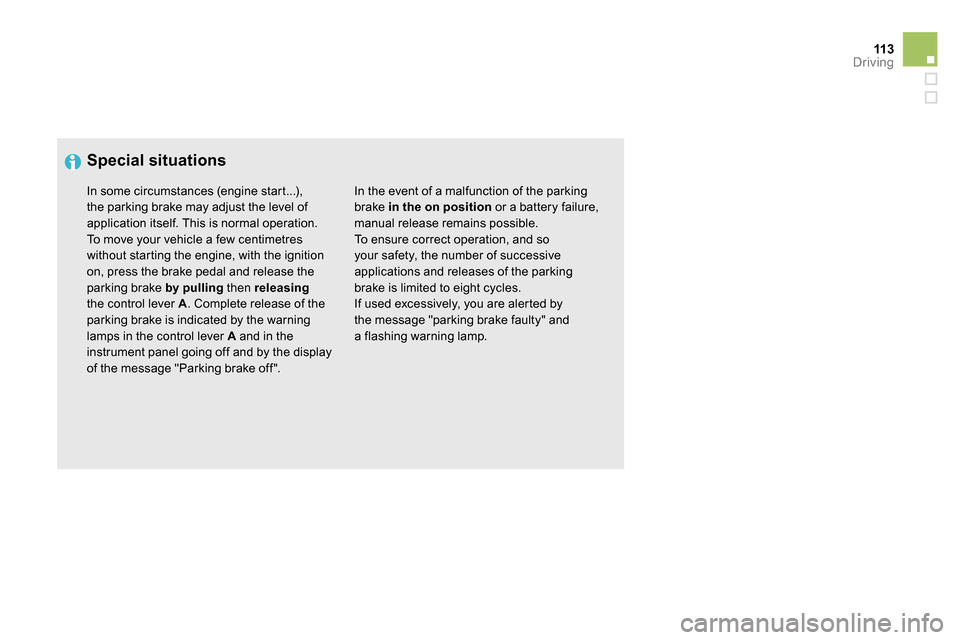
11 3Driving
Special situations
In the event of a malfunction of the parking
brake in the on position
or a battery failure,
manual release remains possible.
To ensure correct operation, and so
your safety, the number of successive
applications and releases of the parking
brake is limited to eight cycles.
If used excessively, you are alerted by
the message "parking brake faulty" and
a flashing warning lamp.
In some circumstances (engine start...),
the parking brake may adjust the level of
application itself. This is normal operation.
To move your vehicle a few centimetres
without starting the engine, with the ignition
on, press the brake pedal and release the
parking brake by pulling
then releasing
the control lever A
. Complete release of the
parking brake is indicated by the warning
lamps in the control lever A
and in the
instrument panel going off and by the display
of the message "Parking brake off ".
Page 118 of 372
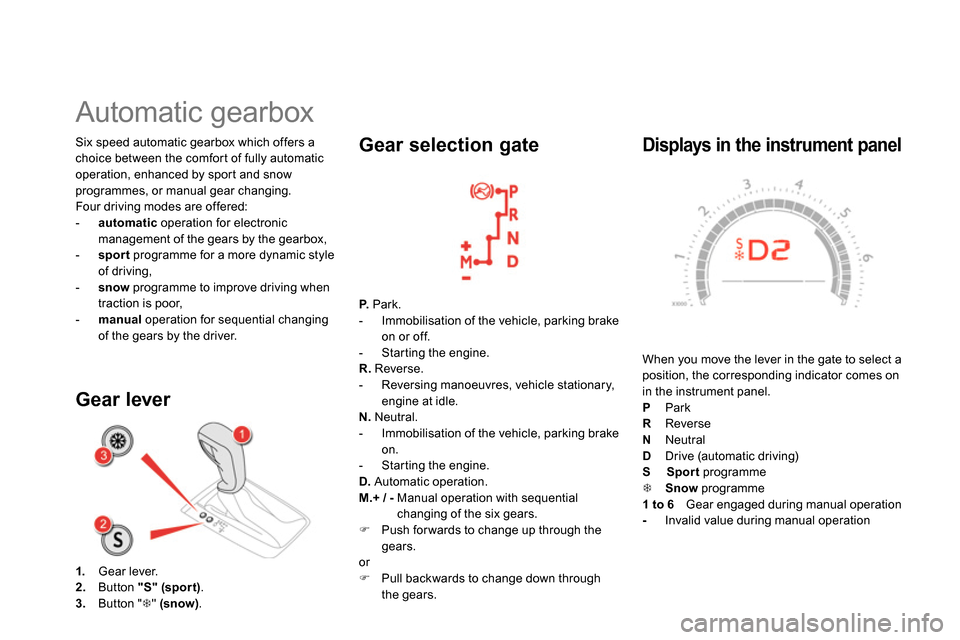
Displays in the instrument panel
When you move the lever in the gate to select a
position, the corresponding indicator comes on
in the instrument panel.
P
Park
R
Reverse
N
Neutral
D
Drive (automatic driving)
S
Sport
programme
Snow
programme
1 to 6
Gear engaged during manual operation
-
Invalid value during manual operation Six speed automatic gearbox which offers a
choice between the comfort of fully automatic
operation, enhanced by sport and snow
programmes, or manual gear changing.
Four driving modes are offered:
- automatic
operation for electronic
management of the gears by the gearbox,
- sport
programme for a more dynamic style
of driving,
- snow
programme to improve driving when
traction is poor,
- manual
operation for sequential changing
of the gears by the driver.
Automatic gearbox
1.
Gear lever.
2.
Button "S"
(spor t)
.
3.
Button "
" (snow)
.
Gear lever
Gear selection gate
P.
Park.
- Immobilisation of the vehicle, parking brake
on or off.
- Starting the engine.
R.
Reverse.
- Reversing manoeuvres, vehicle stationary,
engine at idle.
N.
Neutral.
- Immobilisation of the vehicle, parking brake
on.
- Starting the engine.
D.
Automatic operation.
M.+ / -
Manual operation with sequential
changing of the six gears.
Push for wards to change up through the
gears.
or
Pull backwards to change down through
the gears.